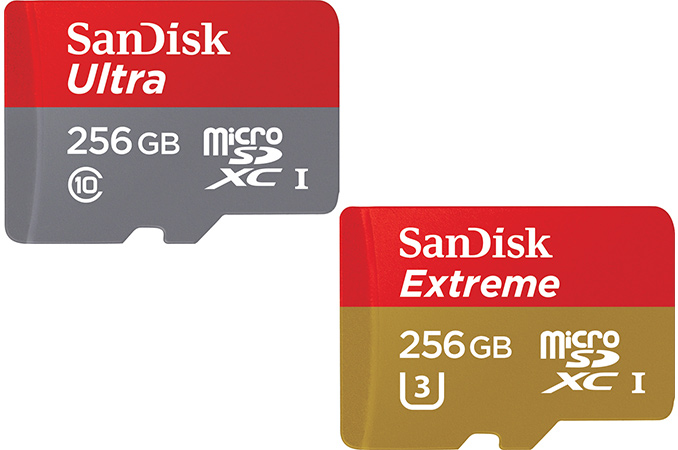Western Digital Rolls Out 256 GB SanDisk microSDXC Memory Cards
by Anton Shilov on June 28, 2016 9:00 PM EST- Posted in
- Memory Cards
- NAND
- SanDisk
- microSDXC

Coinciding with the Mobile World Congress at Shanghai, SanDisk owner Western Digital is introducing two new microSD memory cards that can store up to 256 GB of data. The new SanDisk-branded cards are designed for smartphones, tablets and content-capture devices. The capacities are akin to those of mainstream SSDs, albeit at a higher price.
The new 256 GB memory cards from Western Digital are the SanDisk Extreme microSDXC as well as the SanDisk Ultra microSDXC Premium Edition. Both cards use the UHS-I interface which supports transfer rates of up to 104 MB/s. Compatibility with existing microSDXC and microSDHC devices is retained, but, obviously at lower speeds.
The SanDisk Extreme microSDXC supports read/write speeds of up to 100/90 MB/s, while the SanDisk Ultra microSDXC Premium Edition is slightly slower and features transfer speeds up to 95 MB/s. The Extreme card also has higher minimum sequential write speed - 30 MB/s vs. 10 MB/s, which is important for recording high-bitrate 4K videos.
| SanDisk 256 GB microSDXC Cards at Glance | |||||
| SanDisk Extreme microSDXC | SanDisk Ultra microSDXC Premium Edition | ||||
| Read Speed | up to 100 MB/s | up to 95 MB/s (?) | |||
| Write Speed | up to 90 MB/s | up to 95 MB/s | |||
| Minimum Sequential Write Speed | 30 MB/s | 10 MB/s | |||
| Interface | UHS-I | UHS-I | |||
| Availability | Q4 2016 | August 2016 | |||
| Price | $199.99 | $149.99 | |||
Like other high-end Secure Digital cards, the new 256 GB microSDXC products from Western Digital are waterproof, temperature-proof, shock proof, and X-ray proof, which is useful for those who travel a lot and/or have to use memory cards in harsh conditions.
Western Digital’s SanDisk 256 GB microSDXC cards will not be alone on the market and will compete against Samsung’s EVO Plus 256 GB microSDXC card introduced in May. The latter also features a UHS-I interface and transfer speeds up to 95 MB/s. To build such card, Samsung had to use its 3D V-NAND memory. Meanwhile, SanDisk has not yet disclosed what type of NAND flash it uses to build its high-capacity memory cards.
The 256GB SanDisk Ultra microSDXC UHS-I Premium Edition card will be available worldwide in August 2016 for $149.99. The faster 256GB SanDisk Extreme microSDXC UHS-I card will be available in Q4 2016 for $199.99.
Source: SanDisk














30 Comments
View All Comments
CoreyWat - Tuesday, June 28, 2016 - link
It's just a matter of time, before we see 1TB Micro SD Card.SetiroN - Tuesday, June 28, 2016 - link
Thanks grandpa, you always bring great insight.dsraa - Wednesday, June 29, 2016 - link
You know in my day we had floppy disk. Sonny do you know what a floppy disk is? Do you know how much a floppy disk held? Do you know when that was? 1990. Just 25 years.Yea, do yourself a favor and don't sound so much like an millenial idiot 12 year-old....
SanX - Wednesday, June 29, 2016 - link
...which like all of them after 10 read-writes will unrecoverably dieRictorhell - Tuesday, June 28, 2016 - link
Microdia announced and released images of a 512gb micro sdxc card, LAST summer, which was never actually available to purchase anywhere, as far as I can tell. Samsung, a company with a great reputation, announced a 256gb micro sdxc card last month, for release this month, guess what? I haven't been able to purchase or pre-order it, ANYWHERE. What's the deal memory companies?HomeworldFound - Tuesday, June 28, 2016 - link
If they sell you what you want now, what will they sell you later?SetiroN - Tuesday, June 28, 2016 - link
That microdia announcement was a publicity stunt.Samsung is late to market but I'm sure their cards will be arriving soon as well as Sandisk's.
The only currently available 256gb microSD cards are from Integral. You can find them online (£139 in the UK).
Rictorhell - Tuesday, June 28, 2016 - link
If it was a publicity stunt I hope someone got fired over it because it upset and disappointed A LOT of people.dsumanik - Tuesday, June 28, 2016 - link
The mfg's can and will milk every dime out of current gen products for as long as they possibly can.There is also a war going on with device makers over which format will be supported as the next standard, further slowing adoption. Take XQD for example, been out years now, but only this next upcoming one will see it begin to take off, because nikon finaly decided to support the standard. Everyone else was avoiding due to lame licensing agreements from sony, even though it was the fastest tech available.
I suspect this is directly related to sony supplying sensors for nikon, surely a lower price was offered on sensors in exchange for endorsing XQD on thier new camera bodies..
biofishfreak - Tuesday, June 28, 2016 - link
256GB in microSD form-factor would be great. I have a Surface Pro 4 w/ a microSD slot, and w/ a 128GB Sandisk Extreme, it's fast enough to use with VMware Workstation Pro. I use it mainly for ISOs and base VM images. The reason I spend extra for the Extreme is the lifetime warranty. Otherwise the Ultra is (generally) fast enough.